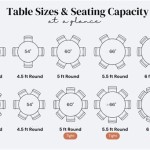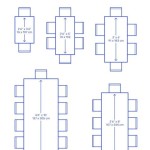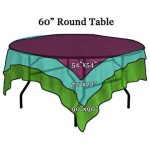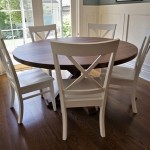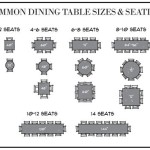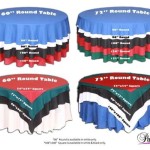How Many Seats for a 60-Inch Round Table
Determining the appropriate number of seats for a 60-inch round table is a common challenge for event planners, homeowners, and anyone organizing a gathering that involves seated dining or activities. The answer isn't simply a single number; rather, it depends on several factors, including the desired level of comfort, the size of the chairs used, and the overall arrangement of the space. This article will provide a comprehensive guide to help accurately estimate the ideal seating capacity for a 60-inch round table, considering these various influencing factors.
A 60-inch round table, which measures 60 inches in diameter (the distance across the circle at its widest point), is a versatile size suitable for a variety of occasions. It’s large enough to provide ample space for place settings, centerpieces, and shared dishes, making it a popular choice for both casual and formal gatherings. However, maximizing its potential requires careful consideration of how many people can comfortably be seated around it.
The aim is to find a balance between maximizing seating capacity and ensuring that each guest has enough personal space to eat, converse, and move comfortably. Overcrowding a table can lead to an uncomfortable and cramped experience, while underutilizing the space can make the setting feel sparsely populated. Therefore, understanding the principles of space allocation is crucial for achieving the desired ambiance and functionality.
Key Point 1: Understanding Comfortable Seating Dimensions
The first step in determining the optimal seating capacity for a 60-inch round table is to understand the dimensions required for comfortable seating. Generally, a minimum of 24 inches of linear table space per person is recommended. This allowance provides enough room for each guest to have their own place setting, including plates, cutlery, glassware, and napkins, without encroaching on their neighbor's space.
Calculating the circumference of the table is necessary to determine the total available seating area. The circumference of a circle is calculated using the formula: Circumference = πd, where 'π' (pi) is approximately 3.14159 and 'd' is the diameter. In the case of a 60-inch round table, the circumference is approximately 3.14159 * 60 inches = 188.5 inches.
Now, divide the total circumference by the minimum recommended linear space per person (24 inches) to estimate the maximum seating capacity: 188.5 inches / 24 inches/person ≈ 7.85 people. This calculation suggests that ideally, around 7 or 8 people can be seated at a 60-inch round table while maintaining a comfortable level of personal space.
However, it’s important to note that this is a theoretical maximum based solely on linear space. Other factors such as chair size and table base design can influence the actual number of people who can be accommodated comfortably.
Furthermore, the type of event should also be considered. A formal dinner might require more personal space per guest compared to a casual buffet-style gathering. In formal settings, guests often require more room for maneuvering and engaging in conversation without feeling cramped.
For example, if wide or bulky chairs are used, they will occupy more space around the table, effectively reducing the available linear space per person. Conversely, using narrower chairs can allow for more people to be seated without compromising comfort significantly.
The base of the table can also impact seating capacity. A central pedestal base, for instance, allows for more legroom and flexibility in seating arrangements compared to a table with four legs that might obstruct some seating positions.
In summary, while the calculation based on the circumference provides a starting point, the actual seating capacity of a 60-inch round table should be adjusted based on the specific circumstances and the desired level of comfort.
Key Point 2: Considering Chair Size and Style
The size and style of the chairs used significantly influence the number of people who can comfortably sit around a 60-inch round table. Chairs vary in width, depth, and armrest design, all of which contribute to the overall space they occupy around the table.
Standard dining chairs typically range in width from 16 to 20 inches. Wider chairs, such as those with armrests or upholstered sides, can easily occupy 22 to 24 inches or more. Therefore, when selecting chairs, it's crucial to consider their dimensions and how they will fit within the overall seating arrangement.
If using wider chairs, reducing the estimated seating capacity based on linear space is necessary. For example, if using chairs that are 22 inches wide, the effective circumference of the table needs to be divided by 22 inches/person instead of 24 inches/person. This would yield a higher estimated seating capacity, but could result in a more cramped experience.
Chairs with bulky armrests can further restrict movement and make it difficult for guests to get in and out of their seats comfortably. Opting for chairs without armrests or with smaller, less intrusive armrests can help maximize the available seating space.
The style of the chair should also complement the overall ambiance of the event. While practicality is important, the aesthetic appeal of the chairs contributes to the overall dining experience. Choosing chairs that are both comfortable and visually appealing is essential for creating a welcoming and enjoyable atmosphere.
Foldable chairs, for instance, are often narrower and more space-efficient than traditional dining chairs. However, they may not offer the same level of comfort or aesthetic appeal. Similarly, ghost chairs, which are made of clear acrylic, can create a sense of spaciousness and visually minimize the impact of the chairs on the overall setting.
Ultimately, the choice of chairs should be a balance between practicality, comfort, and aesthetics, all of which contribute to the overall success of the event. Taking these factors into account when determining the seating capacity of a 60-inch round table is crucial for creating a comfortable and enjoyable dining experience for all guests.
In addition to the width of the chair, the depth (the distance from the front of the seat to the back) also matters. Deeper chairs require more space for guests to pull them away from the table when getting up or sitting down. Consider the average depth of selected chairs to gauge necessary aisle space behind the table. Ideally, there should be at least 36 inches of space between the edge of the table and any walls or other furniture to allow guests to move freely.
Key Point 3: Adjusting for Event Type and Guest Demographics
The type of event and the demographics of the guests significantly influence the ideal seating capacity for a 60-inch round table. A formal dinner party requires a different approach than a casual buffet or a business meeting.
For a formal dinner, providing more space per guest is advisable. This allows for more elaborate place settings, multiple courses, and comfortable conversation. In such settings, limiting the seating capacity to 6 or even 5 people might be more appropriate, even if the table can theoretically accommodate more.
In contrast, a casual buffet or a less formal gathering may allow for squeezing in a few more guests. People tend to move around more during buffets so that the time spent actually seated is reduced. The overall comfort expectations might be lower, allowing closer seating arrangements.
Guest demographics also play a crucial role. If the guest list includes a significant number of elderly individuals or people with disabilities, providing ample space for maneuvering and accessibility is paramount. This could mean reducing the seating capacity to ensure that everyone can move around the table and access their seats with ease.
Similarly, if the event is catering to families with young children, providing a little extra space might be necessary to accommodate high chairs or booster seats. Children are often more active and require more room to move around compared to adults.
The age range and physical characteristics of the guests can also be important factors. Taller individuals might require more legroom, while larger individuals might prefer wider chairs or more personal space. Consider the overall demographics of the guest list and adjust the seating capacity accordingly.
The nature of the activities planned for the event should also be considered. If the event involves activities that require guests to spread out materials or work collaboratively, providing more table space might be necessary. Conversely, if the event is primarily focused on conversation and dining, a slightly more compact seating arrangement might be acceptable.
Ultimately, the goal is to create a comfortable and enjoyable experience for all guests. Taking into account the type of event, the demographics of the guests, and the planned activities will help determine the optimal seating capacity for a 60-inch round table.
Consider the event's flow and schedule. A lengthy sit-down dinner requires more consideration for comfort than a brief meeting or networking event where attendees may not be seated for extended periods. The overall duration of the event should influence decisions on how much space is allocated per person.
In summary, successfully determining the seating capacity for a 60-inch round table requires going beyond a simple calculation of circumference and linear space. It necessitates considering chair size and style, the event type, and guest demographics to create a balanced and inviting atmosphere that prioritizes comfort and functionality.

72 Round Plywood Banquet Table The Chiavari Chair Company

60 Round Table Seat 8 To 10 Destination Events

60 In Round Table Mtb Event Als

60 Round Table Seat 8 To 10 Destination Events

Table Als 60 Inch Round Party Dreams Wedding Event Al

60 In Round Table Mtb Event Als
6 60 Round Tables 36 Chairs

60 In Round Table Mtb Event Als

The Right Number Of Chairs For Any Table Canadel S Blog

60 Round Table Ftp Event Als Facade Theme Party
Related Posts

